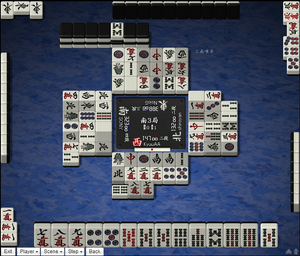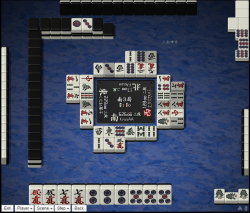Kan

Kan 「カン」 is a special tile call in the game. This call forms a tile grouping of four identical tiles, called kantsu 「槓子」. While appearing as a four-of-a-kind, the tiles used to form kantsu actually function as a three-of-a-kind plus one extra tile. With this in mind, upon calling kan, players are required to make an extra tile draw from the dead wall. This drawn tile is called the rinshanpai, or dead wall draw. After the kan call and player's discard, then another dora indicator is revealed. The strength of kan play stems from the exclusive access to the dead wall and the revealing of additional dora. At the same time, kan play is very risky. Therefore, the ability to call kan is left to a player's discretion.
Procedure

Like the other tile calls, kan is also a tile call. However, it comes with special properties and rules. These rules apply when a player possesses or gains possession of four of the same tile; and then the player makes the kan call.
- The player calls "kan".
- They set aside the four identical tiles next to any open melds. The four tiles now count as one meld.
- They draw a replacement tile from the dead wall to maintain the proper hand size for four melds and a pair.
- The last tile from the wall is added to the dead wall, so that the dead wall contains 14 tiles at all times. Some players omit this step and just end the game when a total of 14 tiles remains in the wall and the dead wall combined.
- The player flips the next dora indicator. Some rules may have this step last depending on the type of kan declared.
- The player may declare a win, declare more kans, or end their turn by discarding normally.
Restrictions
There are some restrictions to calling kan:
- Live wall tiles must still be available for transfer to the dead wall. Otherwise, kan cannot be called.
- Kan called four times by different players invokes suukaikan.
- After taking a discarded tile, a player cannot call kan, even if a player has the tile(s) available to do so. The next chance will be after the next tile draw. Only with a daiminkan would it be possible to call kan on a discard.
- A kan during riichi cannot be called, if the tile waits are altered. Otherwise, it is acceptable.
Tile arrangements
Tiles called for "kan" are set aside. In most cases, they are called for open tile groups. However, one arrangement in particular still indicates a closed hand ("menzen").
Closed
The first arrangement is preferred, but the second arrangement is also acceptable.
Called
Daiminkan are indicated as open tile groups, with the four tiles next to each other and one tile turned to indicate the player it was called from. For daiminkan claims from toimen, or the player across, it does not matter which "middle" tile is turned sideways, as long as it is one of the middle tiles.
Added
Shouminkan are indicated as open tile groups, by stacking the added tile above the rotated tile from the original minkou.
Kan types
Kan can occur under three different occasions; and thus, there are three types of kan based on drawing order:
- Closed triplet with the fourth tile type discarded
- Open triplet with the fourth tile type drawn
- All four tile types drawn
Daiminkan
Daiminkan 「大明槓」 is also called an "open kan". A player possesses three of a tile type within the hand. Then the fourth is discarded. The player may claim the discarded tile and form a daiminkan. Upon doing so, the player has opened the hand, if the hand was initially closed.
Most rules do not allow to flip the kan dora indicator immediately after a daiminkan declaration. It is usually flipped after discarding, or upon another kan declaration on the same turn. Some rules allow the kan dora indicator to be flipped immediately.
A daiminkan may not be made with the last discard of the game, which invokes the follow up procedure to take a rinshanpai. Because all tiles from the regular wall are used, no replacement tile from the regular wall to the dead wall could be made in order to maintain the dead wall at 14 tiles. Taking a rinshanpai in this case would reduce the dead wall count to 13, which not acceptable.
Some rules invoke sekinin barai on a player discarding into the daiminkan.
Shouminkan
Shouminkan 「小明槓」 is referred as an "added kan", where a player had previously called pon to form a minkou, or open triplet. Upon drawing the fourth tile, the player may add that tile to the minkou and upgrade it to a shominkan. If the fourth tile was discarded by another player, it cannot be claimed by kan. The kan dora indicator is flipped at the same time as for a daiminkan. Another term to describe this kan is chakan 「加槓」.
The player may declare this kan during any turn; and therefore, the player does not need to declare kan immediately at first opportunity. If the player has just claimed a discarded tile instead of drawing a tile from the wall or the dead wall, then the ability to declare kan is disabled on this turn. The player would have to wait for the next tile draw instead. It is also forbidden to declare a kan while the wall is empty, because the dead wall cannot be replenished.
This kan call is vulnerable to one specific yaku: chankan or robbing the kan. If another player is tenpai and the added tile completes his hand, that player may call ron immediately after the shominkan declaration. It ends the hand before the kan is completed; therefore no new kan dora indicator is flipped.
Ankan
Also known as a "closed kan", a player may draw all four of a tile type. Unlike the other two kan types, ankan 「暗槓」 keeps the hand closed, unless the hand has been opened previously. Thus, even with an ankan call, the player may still have the option of declaring riichi upon tenpai, and/or winning the hand via mentsumo.
Per rule variation, the kandora indicator is flipped immediately with an ankan call, rather than waiting for the player's discard or the rinshan draw.
Like a shominkan, an ankan may be declared on any turn while the player holds all four tiles. The same restrictions as for the shominkan apply. An ankan may not be subject to chankan, except against a kokushi tenpai, if the rules allow.
Multiple kan calls
If in possession with the proper tiles, a player may call kan more than once consecutively. The extremely rare case of up to four consecutive kan calls within a single turn is possible.
In this example, kan may be called twice in a row after drawing ![]() . Both the
. Both the ![]() and
and ![]() may each be called for shominkan, before making a discard. Naturally, this must be done one at a time, following the proper procedure for kan.
may each be called for shominkan, before making a discard. Naturally, this must be done one at a time, following the proper procedure for kan.
As for kan dora, ankan (closed kan) is the only case, where a new indicator is shown immediately after the kan call. Otherwise, the number of kan indicators is one less than the number of kan consecutive calls. In the case of the above example, two added kans were called sequentially; but only one kan dora indicator was shown upon winning the hand.
Kan during riichi
When a riichi declarer holds three identical tiles and draws the fourth after the riichi announcement, he may form an ankan from these tiles instead of discarding the fourth. The hand composition and the possible winning tiles may not change: it is not allowed to declare kan if, for some possible winning tile, any of the three identical tiles may be interpreted as part of a sequence or part of the pair.
Suukaikan
This is an "abortive draw", regarding kan calls. From the dead wall, only four tile can be used as rinshan pai. The remaining tiles from the dead wall are used as dora indicators, or they are tile replacements from the regular wall. Neither of these two tile type can be used in play. As a result, the limit of kan calls for a hand session is set to four. After the fourth kan call, the kyoku (hand session) ends after the discard, barring that discard cannot be called for a win.
However, an exception is made for players with suu kantsu tenpai. After the fourth kan call, the game continues giving the player a chance to score the yakuman. Other than another player winning, this chance may be abruptly ended with a fifth call for a kan; and the hand ends immediately. Otherwise, the game may continue to ryuukyoku.
Yaku
Two yaku are centered around kan calls. One applies a win via the kan draw; and the other is applied to added kans.
Rinshan kaihou
Rinshan kaihou is a yaku gained by calling tsumo on the replacement tile after any type of kan declaration.
Chankan
Chankan is a yaku applied on a shominkan (added kan) declaration. A hand in tenpai for a kan call on a tile added to a called pon may declare ron on that tile.
Kan risks

The nature of kan dora makes the call for kan a risky maneuver. The additional dora may provide a chance for some self-benefit, but it also gives similar chances for other players to benefit from the additional dora.
Shominkan (Added kan) may give the opponents an opportunity to call ron and claim the chankan yaku.
When in riichi, making an ankan may result in a more dangerous tile being drawn, without the possibility of discarding something else, and therefore dealing into other players' hand and possibly giving them additional dora.
External links
- Kan in Japanese Wikipedia